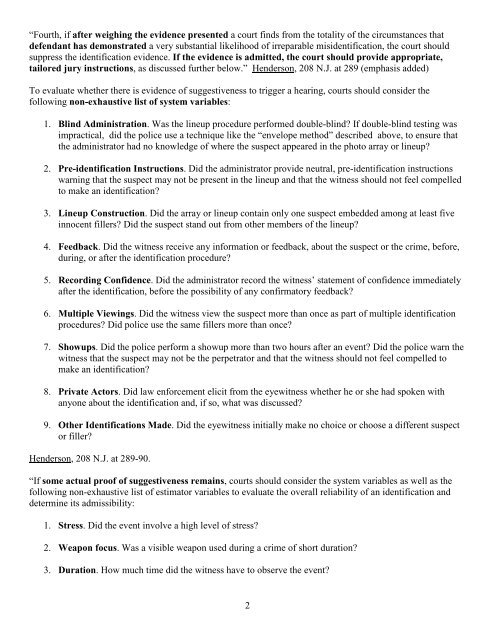State v. Henderson and the New Model Jury Charges - New Jersey ...
State v. Henderson and the New Model Jury Charges - New Jersey ...
State v. Henderson and the New Model Jury Charges - New Jersey ...
Create successful ePaper yourself
Turn your PDF publications into a flip-book with our unique Google optimized e-Paper software.
“Fourth, if after weighing <strong>the</strong> evidence presented a court finds from <strong>the</strong> totality of <strong>the</strong> circumstances that<br />
defendant has demonstrated a very substantial likelihood of irreparable misidentification, <strong>the</strong> court should<br />
suppress <strong>the</strong> identification evidence. If <strong>the</strong> evidence is admitted, <strong>the</strong> court should provide appropriate,<br />
tailored jury instructions, as discussed fur<strong>the</strong>r below.” <strong>Henderson</strong>, 208 N.J. at 289 (emphasis added)<br />
To evaluate whe<strong>the</strong>r <strong>the</strong>re is evidence of suggestiveness to trigger a hearing, courts should consider <strong>the</strong><br />
following non-exhaustive list of system variables:<br />
1. Blind Administration. Was <strong>the</strong> lineup procedure performed double-blind? If double-blind testing was<br />
impractical, did <strong>the</strong> police use a technique like <strong>the</strong> “envelope method” described above, to ensure that<br />
<strong>the</strong> administrator had no knowledge of where <strong>the</strong> suspect appeared in <strong>the</strong> photo array or lineup?<br />
2. Pre-identification Instructions. Did <strong>the</strong> administrator provide neutral, pre-identification instructions<br />
warning that <strong>the</strong> suspect may not be present in <strong>the</strong> lineup <strong>and</strong> that <strong>the</strong> witness should not feel compelled<br />
to make an identification?<br />
3. Lineup Construction. Did <strong>the</strong> array or lineup contain only one suspect embedded among at least five<br />
innocent fillers? Did <strong>the</strong> suspect st<strong>and</strong> out from o<strong>the</strong>r members of <strong>the</strong> lineup?<br />
4. Feedback. Did <strong>the</strong> witness receive any information or feedback, about <strong>the</strong> suspect or <strong>the</strong> crime, before,<br />
during, or after <strong>the</strong> identification procedure?<br />
5. Recording Confidence. Did <strong>the</strong> administrator record <strong>the</strong> witness’ statement of confidence immediately<br />
after <strong>the</strong> identification, before <strong>the</strong> possibility of any confirmatory feedback?<br />
6. Multiple Viewings. Did <strong>the</strong> witness view <strong>the</strong> suspect more than once as part of multiple identification<br />
procedures? Did police use <strong>the</strong> same fillers more than once?<br />
7. Showups. Did <strong>the</strong> police perform a showup more than two hours after an event? Did <strong>the</strong> police warn <strong>the</strong><br />
witness that <strong>the</strong> suspect may not be <strong>the</strong> perpetrator <strong>and</strong> that <strong>the</strong> witness should not feel compelled to<br />
make an identification?<br />
8. Private Actors. Did law enforcement elicit from <strong>the</strong> eyewitness whe<strong>the</strong>r he or she had spoken with<br />
anyone about <strong>the</strong> identification <strong>and</strong>, if so, what was discussed?<br />
9. O<strong>the</strong>r Identifications Made. Did <strong>the</strong> eyewitness initially make no choice or choose a different suspect<br />
or filler?<br />
<strong>Henderson</strong>, 208 N.J. at 289-90.<br />
“If some actual proof of suggestiveness remains, courts should consider <strong>the</strong> system variables as well as <strong>the</strong><br />
following non-exhaustive list of estimator variables to evaluate <strong>the</strong> overall reliability of an identification <strong>and</strong><br />
determine its admissibility:<br />
1. Stress. Did <strong>the</strong> event involve a high level of stress?<br />
2. Weapon focus. Was a visible weapon used during a crime of short duration?<br />
3. Duration. How much time did <strong>the</strong> witness have to observe <strong>the</strong> event?<br />
2
















